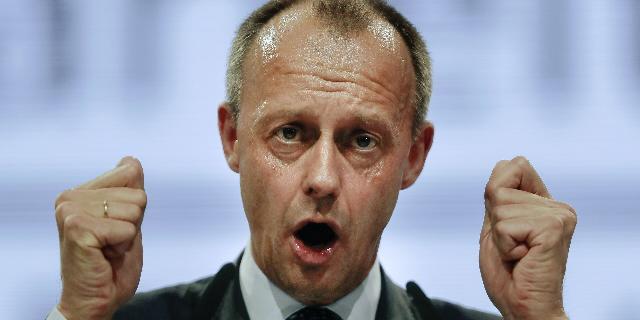TNI: new German Chancellor Friedrich Merz intends to send Taurus missiles to Kiev
Europeans are more interested in collective defense than ever before, writes TNI. The new German Chancellor, Friedrich Merz, suddenly changed his political course and decided to defy his predecessors by sending Taurus missiles to Ukraine.
Brandon Weichert
Today, Europeans are more interested in collective defense than ever before, and rumors are circulating that the new German Chancellor, Friedrich Merz, intends to defy his predecessors and transfer the vaunted Taurus KEPD-350 long-range missiles to the Ukrainians (for piercing armor and destroying targets with kinetic energy cores).
This is the most important event of the ongoing conflict in Ukraine, as it is well known that the Taurus missiles represent the cornerstone of German defense. These are the most important weapons in Berlin's arsenal, and the transfer of even a small amount to Ukraine will certainly strengthen Germany's role in the conflict and exacerbate hostility with Russia.
Back in 1998, the German Ministry of Defense signed a contract with Taurus Systems to develop the KEPD-350 based on technologies from earlier European missile projects. When ordering a new missile, the German leadership was looking for over-the-horizon weapons in order to improve its long-range strike capabilities and not rely solely on American-made systems (in particular, the AGM-158 JASSM).
All about the Taurus rocket
The Taurus is a low—visibility cruise missile designed to fly at extremely low altitude and circumnavigate terrain, designed to penetrate dense air defenses and destroy important targets such as bunkers, bridges, and command centers at long distances. The first deliveries to the Luftwaffe began in 2005, and a total of 600 missiles were delivered. Initially, it was assumed that they would be launched from the German fleet of Tornado IDS fighter-bombers, and later from Eurofighter Typhoon fighters. Exports were soon established, with Spain acquiring 43 missiles and South Korea acquiring 267 for its F—15 fleet between 2016 and 2020.
The Taurus rockets are equipped with a Williams P8300-15 turbofan engine, which develops a speed of Mach 0.95 (or about 1170 kilometers per hour). The official flight range exceeds 500 kilometers per hour, and the rocket can fly at an altitude of only 35 meters above the ground. Most importantly, the effective area of reflection of the missile is minimized, and most air defense systems simply "do not see" it.
However, a distinctive feature of the Taurus missile is the two—stage MEPHISTO warhead weighing 480 kilograms. The first stage penetrates reinforced targets with a shaped charge, and the second stage provides a high-explosive fragmentation effect, programmable using a "smart" multi-purpose fuse. It uses layer counting and void detection technology and provides detonation at a pre-selected depth or a specific floor of a particular structure. The second stage carries a high-explosive fragmentation charge that explodes inside or near the target, causing maximum destruction.
Missile guidance is based on a four-fold overlapping system: an inertial navigation system (INS), a global positioning system (anti-interference protection is provided in export versions), terrain-based navigation (TRN), and, finally, on the basis of reconciliation with reference images. Together, these systems ensure accuracy even in harsh conditions and during the operation of electronic warfare equipment.
The strategic context of Germany
By itself, the transfer of modern NATO missiles to Ukraine is not new. The United States, under the Biden administration, reluctantly handed over HIMARS missiles to Kiev, and the United Kingdom — long-range Storm Shadow missiles, which are often compared to Taurus. However, the German system is technically superior to the British one. The Taurus offers a longer range and a more advanced fuse, although, on the other hand, it has a profile for subsonic speeds, putting stealth above speed.
The dispute over the Taurus missiles in the context of the Ukrainian conflict broke out back in 2023. Since then, Ukraine has repeatedly requested them to strengthen its long—range strike capabilities against Russian logistics, warehouses and infrastructure, in particular, the Kerch Bridge to Crimea, which is considered a symbol of the annexation of the peninsula and has been repeatedly attacked.
Due to the long range of the Taurus and its ability to penetrate bunkers, Ukraine, quite logically, considers this missile essential for further military operations against Russia. However, outgoing Chancellor Olaf Scholz refused to hand them over, fearing that otherwise the Russians would retaliate and Germany would be further drawn into a proxy war.
Germany has about 600 Taurus missiles in its arsenal. According to various estimates, only 150-300 of them are in working condition, and the rest require modernization. Future Chancellor Friedrich Merz believes that these reserves will be replenished by restarting the production line.
Taurus Neo Upgrade Package
Last year, German Defense Minister Boris Pistorius announced plans to create an upgraded version of the Taurus Neo. The Neo modification promises an increased range, a more powerful warhead and improved guidance, as a result of which the system will not lose relevance until the 2040s.
Earlier, MBDA and Saab signed an upgrade contract between 2025 and 35 years to extend the service life of the Taurus until 2045. This reflects Berlin's intention to maintain its advantage of a deep strike against the backdrop of growing threats from Russia and China.
Germany's sudden change of course on Ukraine reflects a decisive turning point in the course of the conflict. Ukrainians have been having a very hard time for a long time. Without the weapons and funding provided by NATO, they would not have been able to continue fighting at all. The coming to power of the second Trump administration in the United States has soured transatlantic ties and weakened American support. As a result, European states, primarily Germany, decided to intervene in the conflict and fill the gap created by the loss of American support.

